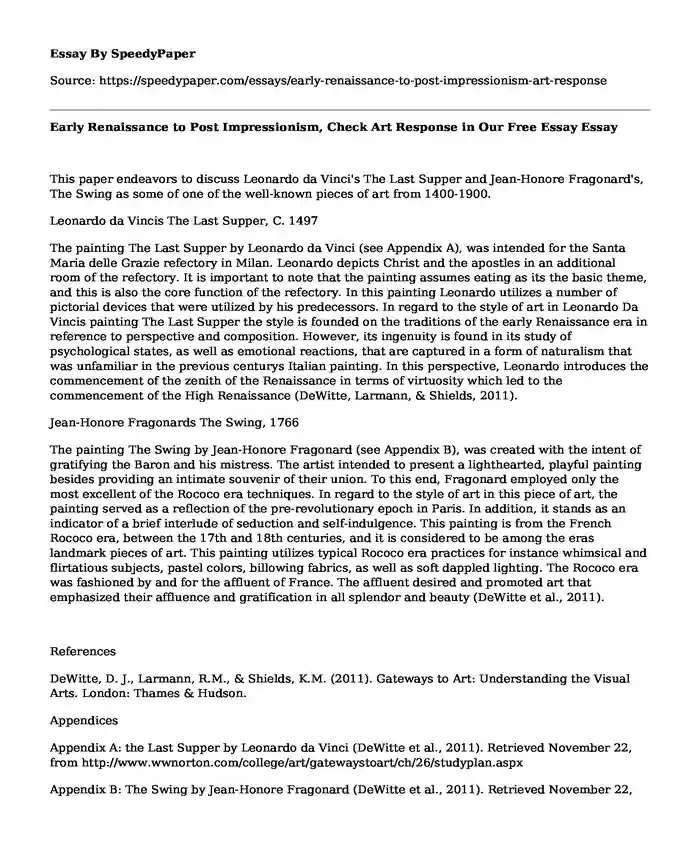This paper endeavors to discuss Leonardo da Vinci's The Last Supper and Jean-Honore Fragonard's, The Swing as some of one of the well-known pieces of art from 1400-1900.
Leonardo da Vincis The Last Supper, C. 1497
The painting The Last Supper by Leonardo da Vinci (see Appendix A), was intended for the Santa Maria delle Grazie refectory in Milan. Leonardo depicts Christ and the apostles in an additional room of the refectory. It is important to note that the painting assumes eating as its the basic theme, and this is also the core function of the refectory. In this painting Leonardo utilizes a number of pictorial devices that were utilized by his predecessors. In regard to the style of art in Leonardo Da Vincis painting The Last Supper the style is founded on the traditions of the early Renaissance era in reference to perspective and composition. However, its ingenuity is found in its study of psychological states, as well as emotional reactions, that are captured in a form of naturalism that was unfamiliar in the previous centurys Italian painting. In this perspective, Leonardo introduces the commencement of the zenith of the Renaissance in terms of virtuosity which led to the commencement of the High Renaissance (DeWitte, Larmann, & Shields, 2011).
Jean-Honore Fragonards The Swing, 1766
The painting The Swing by Jean-Honore Fragonard (see Appendix B), was created with the intent of gratifying the Baron and his mistress. The artist intended to present a lighthearted, playful painting besides providing an intimate souvenir of their union. To this end, Fragonard employed only the most excellent of the Rococo era techniques. In regard to the style of art in this piece of art, the painting served as a reflection of the pre-revolutionary epoch in Paris. In addition, it stands as an indicator of a brief interlude of seduction and self-indulgence. This painting is from the French Rococo era, between the 17th and 18th centuries, and it is considered to be among the eras landmark pieces of art. This painting utilizes typical Rococo era practices for instance whimsical and flirtatious subjects, pastel colors, billowing fabrics, as well as soft dappled lighting. The Rococo era was fashioned by and for the affluent of France. The affluent desired and promoted art that emphasized their affluence and gratification in all splendor and beauty (DeWitte et al., 2011).
References
DeWitte, D. J., Larmann, R.M., & Shields, K.M. (2011). Gateways to Art: Understanding the Visual Arts. London: Thames & Hudson.
Appendices
Appendix A: the Last Supper by Leonardo da Vinci (DeWitte et al., 2011). Retrieved November 22, from http://www.wwnorton.com/college/art/gatewaystoart/ch/26/studyplan.aspx
Appendix B: The Swing by Jean-Honore Fragonard (DeWitte et al., 2011). Retrieved November 22, from http://www.wwnorton.com/college/art/gatewaystoart/ch/27/studyplan.aspx
Cite this page
Early Renaissance to Post Impressionism, Check Art Response in Our Free Essay. (2019, Jun 24). Retrieved from https://speedypaper.com/essays/early-renaissance-to-post-impressionism-art-response
Request Removal
If you are the original author of this essay and no longer wish to have it published on the SpeedyPaper website, please click below to request its removal:
- Marketing Principles and Practice: TOMS Case Study Example
- Free Essay on the Process of Developing a Thesis or Argument
- Hawaii Population Essay Sample
- Application for Admission to the Masters in Arts in Counseling Psychology Program
- Literary Essay Sample: The World of 2018 vs.The World of the Future
- The Walkout Before the Storm - Creative Writing Essay Example
- Paper Example on European History Image
Popular categories





